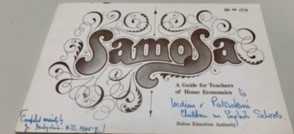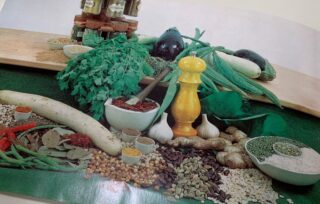
Cover photo from annotated copy of Samosa- A guide for teachers of Home Economics
held by Hertfordshire Archive and Local Study
DE/Hk/5/1/8
Bolton Education Authority: Home Economics
In 1945 the Bolton Education Authority published a guide for teachers of Home Economics to help assist the learning of new immigrant children from India and Pakistan in English schools. There was a need to connect the two cultures and help introduce home life differences to better settle newly arrived families. Many teachers were unaware of the dramatic upset many immigrant children endured in their quick transition from life in their native homelands to life in a foreign country with new buildings, new surroundings and new ways of living but very little communication. There was an awareness by authorities to this frightening experience for children and a hope that this publication might help to ease that transition for the pupils and also inform educators of the challenges faced by these students before they even enter the classroom.

Inset photo from annotated copy of
Samosa- A guide for teachers of Home Economics held by Hertfordshire Archive and Local Study
DE/Hk/5/1/8
Home Differences
Some of the challenges that needed to be taught were everyday occurrences in the home that teachers from Western Civilisations might take for granted. These were outlined as differences between rural living in India or Pakistan verses town living in England. For example: How homes were constructed; single room dwellings vs multiple room homes. Stabling animals within the home with the family vs keeping animals in a separate outbuilding. Cooking on a fire vs using a gas or electric stove or oven. Food storage in kitchen cupboards not in cold damp cellars where vermin or mould could damage supplies. Different styles of bed and bed coverings, window dressings and furniture that may look unfamiliar. How refuse is collected and stored. Use of lavatories and how to clean them. There was an urgent need for educators to step in and help teach the children how to use this new equipment and encourage them to go home and teach their parents what they had learned.
Considerations

Photo of spices from annotated copy of
Samosa- A guide for teachers of Home Economics held by Hertfordshire Archive and Local Study
DE/Hk/5/1/8
The guide also talks about differences in cooking equipment, food preparation, customs and religious restrictions. The introduction of measurement for ingredients in cooking was one of the key differences to consider. Many of the pupils did not see their parents use weights or measurements when cooking and so were unfamiliar with their use. Utensils were mostly the same between the cultures or similar equivalents could be found if needed. The use of spice and seasoning was highlighted as essential to make dishes that would be accepted in their homes by family members. Also, the consideration of religious differences during the year which effected the Home Economics course structure, such as observing Ramadan and Eid celebrations. There was a great communication barrier to get through with pupils and parents who learned English as a second language. The guide talks about terms that might be unfamiliar to English educators like curry, sambal, and chutneys.
Coming Together
Overall the thought of the time was that “… through the children the parents of this generations can be educated…”. In may cases this was true, older generations did learn the ways of Western culture through their children at home, but they also taught the educators in return. Today we have a wonderful mix of cultures and ideas with influences from all over the globe. As we embrace new and different cultures it is important to continue what began over 80 years ago with an exchange of ideas and traditions, a collaboration of both teaching and learning as we merge together.






Add your comment about this page